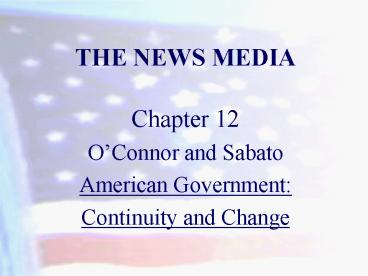THE NEWS MEDIA PowerPoint PPT Presentation
Title: THE NEWS MEDIA
1
THE NEWS MEDIA
- Chapter 12
- OConnor and Sabato
- American Government
- Continuity and Change
2
THE NEWS MEDIA
- In this chapter we will cover
- The American Press of Yesteryear
- The Contemporary Media
- How the Media Cover Politicians and Government
- The Media's Influence on the Public
- How Politicians Use the Media
- Government Regulation of the Electronic Media
3
A Complex Relationship
- The relationship between the media and
policymakers is both subtle and complex. - No easy conclusions about who influences whom in
what circumstances can be drawn. - Television has quickened the pace of the news but
it by no means determines American public policy. - However, it is also clear that the media is a
powerful institution that affects multiple facets
of American political life.
4
The Media of Yesteryear
- The first (printed in the 1690s) American
newspapers were controlled by the political
parties. - By the 1890s 'yellow journalism' sold millions of
newspapers. - Throughout the 19th century, payoffs to the press
were common.
5
Technological Advances
- Papers became cheaper and easier to produce and
distribute, the telegraph and telephone made
reporting simpler and faster. - Radio became widely available in the 1920s and
television was introduced in the late 1940s. - Cable was invented in the 1970s, CNN was founded
in 1980, and the Internet didn't become
well-known until the late 1990s.
6
A Reciprocal Relationship
- Politicians actively court the medias favor and
ascribe to the media the power to make or break
government policy. - Research shows that the mass media have an effect
both on public opinion and on the shape of policy
choices decision makers face.
7
The Contemporary Media
- A number of newspapers have a national audience
and are considered quite influential - The New York Times
- The Wall Street Journal
- USA Today
- The Christian Science Monitor
- The Washington Post
- The Los Angeles Times
- These newspapers have a huge effect on television.
8
(No Transcript)
9
The Pace of the News
- The increasing rapid pace of electronic news and
televisions global coverage shortens the time
frame for policy responses. - In 1961, when the Berlin Wall went up, President
Kennedy had 8 days to respond to the provocative
action. - In 1989, when the wall came down, President Bush
was forced to respond overnight.
10
(No Transcript)
11
The Media and Politicians
- Research indicates that roughly 2/3s of officials
in policy decisions reported that the media was
their most rapid source of information. - Over 4/5s indicated that the media were an
important source of information.
12
(No Transcript)
13
How Politicians Use the Media
- Politicians and government officials often stage
media events in order to gain free media
coverage. - Candidates and politicians try to control or
'spin' media focus regarding campaign and policy
issues. - Candidates and politicians may 'leak' a story to
the press in order to get their story out without
being the focus of that story.
14
New York Times
- Ive said many times that I never learned from a
classified document anything I couldnt get
earlier or later from the New York Times. - John Kenneth Galbraith
15
The Media and the Public
- Knowledge is power.
- 98 of all American households own at least one
television. - There are over 1500 newspapers with daily
circulations of 60 million. - There are 3 major weekly news magazines that
claim nearly 10 million readers.
16
Agenda Setting
- The mass media may not be successful in telling
people what to think, but they are stunningly
successful in telling their audience what to
think about. - This power is greatest among those who are
neither interested nor involved in politics and
hence lack political sophistication.
17
The Medias Role
- The mass media perform a MEDIATING role helping
to shape political attitudes and choices but not
DETERMINING them.
18
Television Network Programming
- A full transcript of the typical nightly network
news broadcasts foreign and domestic would
not fill half of the front page of an average
daily newspaper. - Yet ¾ of the American people routinely depend on
this source for most of their foreign affairs
information.
19
The Inadvertent Audience
- Television provides the mass of American people
with an infusion of policy information that most
neither like nor want. - There are three consequences of this forced
media - Television may explain the decline of confidence
in the nations leadership. - Being uninterested, Americans are unlikely to
have strong convictions about issues as do those
who regularly follow political affairs. - Policy ideas must fit into one-liners that will
fit into 30, 60, or 90 second slots on the
evening news.
20
Imperviousness of Beliefs
- Generally neither reading nor watching the news
alters what people think. - Selective perception is a pervasive human
tendency. - People search for comfortable information that
fits with preexisting beliefs. - People screen out or reject information with
which they disagree. - In short, we see what we want to see and hear
what we want to hear.
21
Government Regulation of the Electronic Media
- Print media are exempt from most governmental
regulation. - Electronic media are not.
- Airwaves are considered public property and are
leased to networks and private broadcasters by
the government. - Government also allocates the use of frequencies
and channels so that radio and TV do not overlap
and jam each others' signals.
22
The Medias Influence
- Do the media have too much influence on
policymaking? If so why? - If not, why do so many people think the media are
so influential? - How should a citizen use the media?
- Should we always believe the news media when they
make claims? - How can we become better consumers of information?

